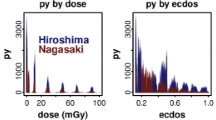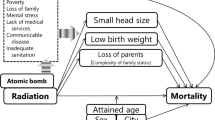Abstract
Three breast cancer risk factors were evaluated in terms of their interactions with radiation dose in a case-control interview study of Japanese A-bomb survivors. Cases and controls were matched on age at the time of the hombings and radiation dose, and dose-related risk was estimated from cohort rather than case-control data. Each factor—age at first full-term pregnancy, number of deliveries, and cumulative lactation period summed over births—conformed reasonably well to a multiplicative interaction model with radiation dose (the additive interactive model, in which the absolute excess risk associated with a factor is assumed to be independent of radiation dose, was rejected). An important implication of the finding is that early age at first full-term pregnancy, multiple births, and lengthy cumulative lactation are all protective against radiation-related, as well as baseline, breast cancer. Analyses by age at exposure to radiation suggest that, among women exposed to radiation in childhood or adolescence, a first full-term pregnancy at an early agefollowing exposure may be protective against radiation-related risk.
Similar content being viewed by others
References
Land CE, Hayakawa N, Machado S, et al. A case-control interview study of breast cancer among Japanese A-bomb survivors. I. Main effects.Cancer Causes Control 1994;5: 157–65.
Wanebo CK, Johnson KG, Sato K, Thorslund TW. Breast cancer after exposure to the atomic bombings of Hiroshima and Nagasaki.N Engl J Med 1968;279: 667–71.
McGregor DH, Land CE, Choi K, et al. Breast cancer incidence among atomic bomb survivors, Hiroshima and Nagasaki, 1950–1969.JNCI 1977,59: 799–811.
Tokunaga M, Norman JE, Asano M, et al. Malignant breast tumors among atomic bomb survivors, Hiroshima and Nagasaki, 1950–74.JNCI 1979;62: 1347–59.
Tokunaga M, Land CE, Yamamoto T, et al. Incidence of female breast cancer among atomic bomb survivors, Hiroshima and Nagasaki, 1950–1980.Radiat Res 1987;112: 243–72.
Tokunaga M, Land CE, Tokuoka S,et al. Incidence of female breast cancer among atomic bomb survivors, Hiroshima and Nagasaki, 1950–1985.Radiat Res 1994;138: in press.
Mole RH. The sensitivity of the human breast to cancer induction by ionizing radiation.Br J Radiol 1978;51: 401–5.
Land CE, Tokunaga M, Tokuoka S, Nakamura N. Early-onset breast cancer among atomic bomb survivors: Evidence of a radiation-susceptible subgroup?Lancet 1993;342: 237.
Land CE, Boice JD Jr, Shore RE, Norman JE, Tokunaga M. Breast cancer risk from low-dose exposures to ionizing radiation: Results of parallel analysis of three exposed populations of women.JNCI 1980;65: 353–76.
Land CE, Tokunaga M, Tokuoka S. Studies of breast cancer risk among atomic bomb survivors (and discussion following). In: Gerber GB, Taylor DM, Cardis E, Thiessen JW, eds,The Future of Human Radiation Research. London, UK: British Inst of Radiology, 1991: 49–60;BIR Report 22.
MacMahon B, Cole P, Brown J. Etiology of human breast cancer: A review.JNCI 1973;50: 21–42.
Henderson BE, Pike MC, Gray GE. The epidemiology of breast cancer. In: Hoogstraten B, McDivitt RW, eds,Breast Cancer Boca Raton, FL, USA: CRC Press, 1981: 1–25.
Kelsey JL, Horn-Ross PL. Breast cancer: magnitude of the problem and descriptive epidemiology.Epidemiol Rev 1993;15: 7–16.
Kelsey JL, Gammon MD, John EM. Reproductive factors and breast cancer.Epidemiol Rev 1993;15: 36–47.
Ziegler RG, Hoover RN, Pike MC, et al. Migration patterns and breast cancer risk in Asian-American women.JNCI 1993;22: 1819–27.
Land CL.A Nested Case-control Approach to Interactions between Radiation Dose and Other Factors as Causes of Cancer. Hiroshima, Japan: Radiation Effects Research Foundation, 1990; RERF Commentary and Review Series CR 1-90.
Beebe GW, Usagawa M.The Major ABCC Samples. Hiroshima, Japan: Atomic Bomb Casualty Commission, 1968;ABCC Technical Report No. 12.
Shimizu Y, Kato H, Schull WJ. Studies of the mortality of A-bomb survivors. 9. Mortality, 1950–1985: Part 2. Cancer mortality based on the recently revised doses (DS86).Radiat Res 1988;121: 120–41.
Milton RC, Shohoji T.Tentative 1965 Radiation Dose (T65D) Estimation for Atomic Bomb Survivors, Hiroshima-Nagasaki. Hiroshima, Japan: Atomic Bomb Casualty Commission 1968; Tech. Report No. 1.
Kerr GD. Organ dose estimates for the Japanese atomic bomb survivors.Health Phys 1979;37: 487–508.
Radiation Effects Research Foundation. U.S. Joint Reassessment of Atomic Bomb Radiation Dosimetry in Hiroshima and Nagasaki—Final Report, Vol. 1. Hiroshima, Japan: RERF, 1987.
Radiation Effects Research Foundation. U.S. Joint Reassessment of Atomic Bomb Radiation Dosimetry in Hiroshima and Nagasaki-Final Report, Vol. 2. Hiroshima, Japan. RERF, 1988.
Mabuchi K, Soda M, Ron E, et al.Use of the Tumor Registries in Hiroshima and Nagasaki for Incidence Studies in the Atomic Bomb Survivors. Hiroshima, Japan: Radiation Effects Research Foundation, 1991;RERF Commentary and Review Series CR 3-91.
Lubin JH. A computer program for the analysis of matched case-control studies.Comput Biomed Res 1981;14: 138–43.
Preston DL, Lubin JH, Pierce DA.Epicure User's Guide. Seattle, WA, USA: Hirosoft International Corporation, 1992.
Boice JD Jr, Stone BJ. Interaction between radiation and other breast cancer risk factors. In: International Atomic Energy Agency,Late Biological Effects of Ionizing Radiation. Vienna, Austria: International Atomic Energy Agency, 1978; Vol. I: 231–47.
Shore RE, Woodward ED, Hempelmann LH, Pasternack BS. Synergism between radiation and other risk factors for breast cancer.Prev Med 1980;9: 815–22.
Kato H, Schull WJ. Studies of the mortality of A-bomb survivors. 7. Mortality, 1950–1978: Part 1. Cancer mortality.Radiat Res 1982;90: 395–432.
Boice JD Jr, Harvey EB, Blettner M, Stovall M, Flannery JT. Cancer in the contralateral breast after radiotherapy for breast cancer.New Engl J Med 1992;326: 781–5.
Kopecky KJ, Nakashima W, Yamamoto T, Kato H. Lung cancer, radiation, and smoking among A-bomb survivors, Hiroshima and Nagasaki. Hiroshima and Nagasaki, Japan: Radiation Effects Research Foundation, 1986; TR 13–36.
National Academy of Sciences.Health Risks of Radon and Other Internally Deposited Alpha-Emitters (BEIR IV Report). Washington DC, USA: Natl Acad Press, 1988.
Russo J, Gusterson BA, Rogers AE, Russo IH, Wellings SR, van Zwieten MJ. Comparative study of human and rat mammary tumorigenesis.Lab Invest 1990;62: 244–78.
Clifton KH, Sridharan BN, Douple EB. Mammary carcinogenesis-enhancing effect in irradiated rats with pituitary tumor MtT-F4.JNCI 1975;55: 485–7.
Clifton KH, Criwley J. Effects of radiation type and role of glucocorticoids, gonadectomy and thyroidectomy in mammary tumor induction in MtT-grafted rats.Cancer Res 1978;38: 1507–13.
Author information
Authors and Affiliations
Additional information
The Radiation Effects Research Foundation (formerly the Atomic Bomb Casualty Commission) was established in April 1975 as a private nonprofit Japanese Foundation, supported equally by the Government of Japan through the Ministry of Health and Welfare, and the Government of the United States through the National Academy of Sciences under contract with the Department of Energy. The present work was performed as part of a collaboration between RERF and the US National Cancer Institute.
Rights and permissions
About this article
Cite this article
Land, C.E., Hayakawa, N., Machado, S.G. et al. A case-control interview study of breast cancer among Japanese A-bomb survivors. II. Interactions with radiation dose. Cancer Causes Control 5, 167–176 (1994). https://doi.org/10.1007/BF01830263
Received:
Accepted:
Issue Date:
DOI: https://doi.org/10.1007/BF01830263




